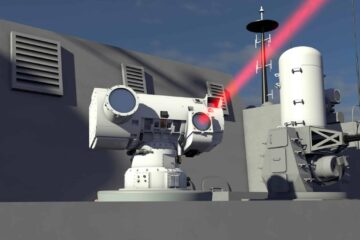Multi-Role Ocean Surveillance (MROS) vessels will act as subsea protection ships. The first vessel is due to be operational in Summer 2023.
UK MoD press release
Once operational, the ship will be dedicated to safeguarding seabed telecommunications cables and oil and gas pipelines. The 98-metre-long, adaptable offshore patrol vessel – the length of Big Ben – will act as a ‘mother ship’, operating remote and autonomous offboard systems for underwater surveillance and seabed warfare, vital to our national security.
Multi-Role Ocean Surveillance (MROS) ship
Shortly after arriving at Cammell Laird, the ship will be repainted and have critical military equipment installed, before taking up its role as the first of two Multi-Role Ocean Surveillance (MROS) ships, operated by the Royal Fleet Auxiliary (RFA) later this year.
“The vessel will be formally handed over to control of the RFA in the next few days, several months ahead of schedule – following an acceleration of the acquisition announced by the Defence Secretary in November 2022.
It is paramount at a time when we face Putin’s illegal invasion of Ukraine, that we prioritise capabilities that will protect our critical national infrastructure.”
Defence Secretary, Ben Wallace
The vessel – currently named ‘Topaz Tangaroa’, but due to be renamed as it joins the RFA fleet – was selected to meet the requirements of the Royal Navy, having been built four years ago to support a mix of underwater operations, including work on oil rigs, construction, maintenance and inspection work, as well as autonomous submarine operations.
The 6,000-tonne vessel is equipped with a helipad, crane, and expansive working deck and features a ‘moon pool’ – a large access point in the underside of the hull through which submersible capabilities can be launched.
“This is an entirely new mission for the Royal Fleet Auxiliary – and one we relish.
Head of the Royal Fleet Auxiliary, Commodore David Eagles RFA
We have been entrusted with supporting a key operation to safeguard the UK’s infrastructure, security and prosperity and that fills all of us in the RFA with pride. These are really exciting times.”
The vessel, will be crewed by around two-dozen RFA sailors, while around 60 Royal Navy specialists will operate the undersea surveillance systems and other survey and warfare systems when embarked.
“DE&S worked at pace to successfully accelerate the purchase and delivery of the first ship under the critical MROS programme. We continue to work with agility to support the UK MOD in addressing both the current and future threats posed by an ever-changing world.”
DE&S Director General Ships Vice Admiral Paul Marshall
The vessel is due to enter operational service in Summer this year, with the programme for the acquisition of a second ship currently in concept phase.
-End-
Naval News comments:
The ship will become the UK’s first ship dedicated to safeguarding vital seabed telecommunications cables and oil and gas pipelines, beginning operations in just six months’ time.
The 6,000-tonne vessel, which is equipped with a helipad, crane, and a large (1,000 square metres) working deck has most recently been operating in the Pacific on underwater construction projects.
According tot he Royal Navy, the ship was built in Norway four years ago to support a mix of underwater operations such as work on oil/gas rigs, construction, maintenance and inspection work, as well as survey and remotely-operated vehicle/autonomous submarine operations, making her ideal for underwater surveillance and seabed warfare.
To learn more about MROS, check out our recent article on the program:






